Kitchens are very popular locations for aluminium bifold doors. Customers either install interior bi-fold doors to separate a kitchen from a dining area or living space, or use kitchen bi-fold doors that open out onto a patio or garden.
In this guide, we help you choose the right type of bifold door for your kitchen, suggesting possible designs, floor plans and layouts. We also look at different configurations and sizes, explaining factors such as bifold door energy efficiency and locking systems.
Click on a link to jump to that section:
Find out more about the differences between bifolds, sliding doors and French doors.
Read the key benefits of aluminium bifold doors, and whether they are suitable for you.
Find out more about what you can expect to pay for a bifold door.
We provide you with some design inspiration for your kitchen bifold door.
Read our tips on installing your bifold door.
We explain the different accessory options for internal bifold doors.
Your options for kitchen internal doors: should you choose bifolds, sliding doors or French doors?
If you’re installing internal doors to separate your kitchen from another room, we’d usually recommend bi-folds or French doors.
This is because French doors and bi-fold doors leave a larger opening than sliding doors. Bi-fold doors fold and stack fully to one side, while French doors open out fully or to as far as the wall will allow.
With sliding doors, however, the sliding panel sits in front of or behind the other panel, leaving some of the aperture partially blocked.
Bear in mind though that French doors aren’t available in sizes that would open up a large wall, and are more appropriate for narrow walls.
If you want to open up your entire kitchen into an open-plan dining area, or connect it with your patio, decking or other outdoor space in the summer months, sliding patio doors or bi-fold doors are the best option.
Read our guide to sliding doors vs bifold doors here.
Are you looking for a modern kitchen bifold door?
VIEW ORIGIN ALUMINIUM BIFOLD DOORS
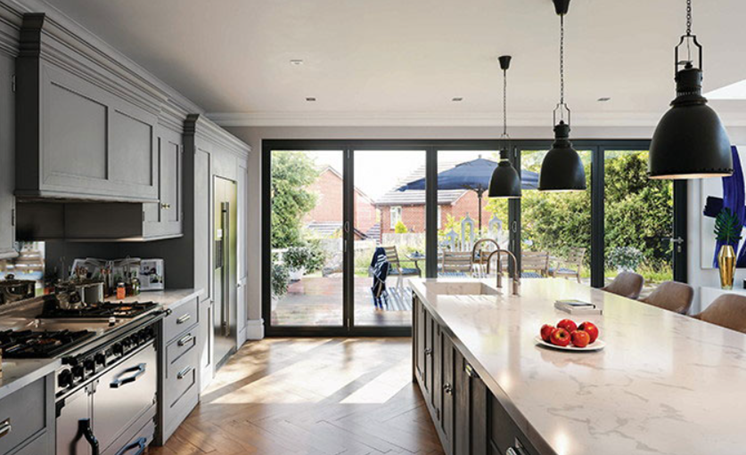
Created bespoke to ensure you can make the most of your space, Origin bi-folds range from one to twelve door sets and individual doors can be manufactured as narrow as 400mm, as wide as 1200mm and as tall as 3000mm. You can choose how they open and close – whether they fold in or out, the configuration of where they open from and the direction they slide – to meet your exact needs.
Sliding doors vs bi-fold doors: how to choose between them
Sliding doors and bi-fold doors have many of the same benefits. If you choose high-quality doors, they should have the following benefits:
- They are extremely energy efficient (particularly when paired with energy saving glass)
- They have thin sightlines and offer a great view
- They are flexible in terms of size options
- They are available in a number of different materials (though we'd always recommend you choose aluminium doors).
The main thing to consider is that sliding doors are somewhat limited if you want to open up the entire space, since you’ll always have one pane that doesn’t slide back as the other panes need to slide behind it.
Bi-fold doors, on the other hand, can fold back completely. Also, you can install corner bi-fold doors so that, when folded back, the corner disappears completely (this is sometimes called a floating corner bi-fold door).
See a more detailed comparison of bi-folds, sliding doors and French doors.
Are you looking for a durable aluminium sliding door?
VIEW ORIGIN ALUMINIUM SLIDING DOORS
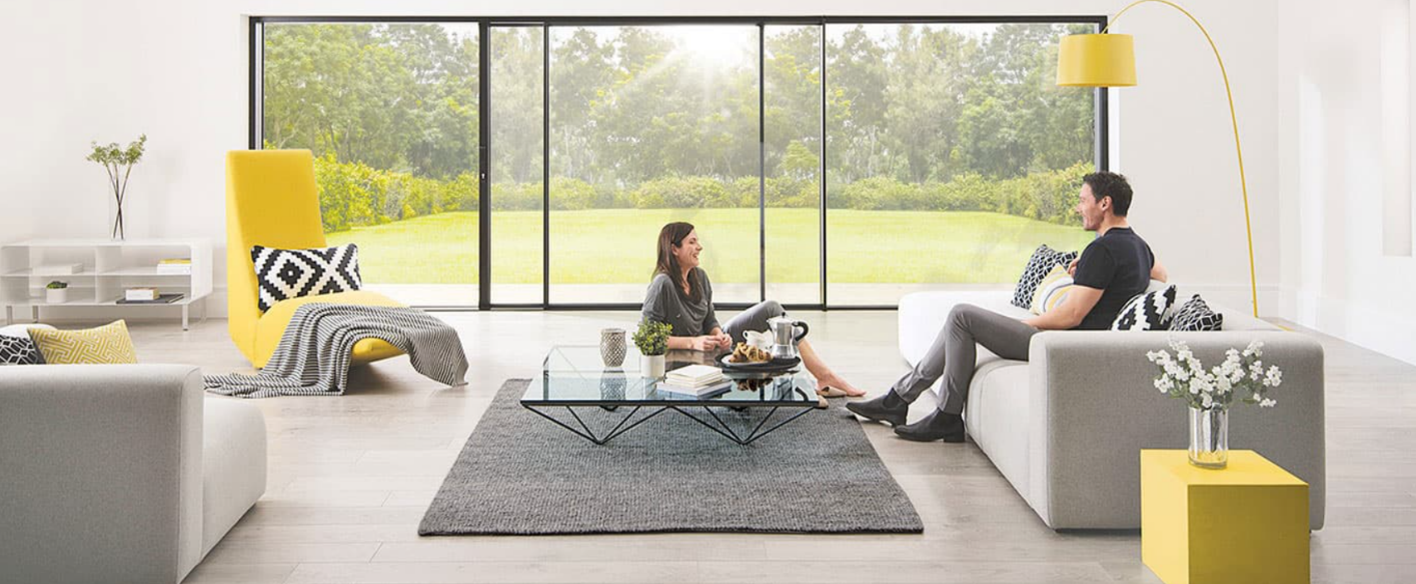
Delivering first-in-class design, our sliding door range provides the most spectacular finish for any building project. Available in four different sightlines across two different sliding door systems – the Origin OS-29+ slider and the Origin Patio Slider – we have some of the slimmest sliding doors on the market, allowing for some of the largest glass expanses to be achieved to offer maximum, uninterrupted views whilst not compromising on quality or thermal performance. Both systems are modern, architecturally striking variations on the traditional patio door system.
Shop the Origin Sliding Door range
Are aluminium bifold kitchen doors the right option for you?
Bi-fold doors generally come in three materials:
- Aluminium
- uPVC
- Timber
Steel bi-fold doors are available but they’re far less common. This is because they’re considerably more expensive and more difficult to manufacture. They are technically a stronger type of door, but they’re also far heavier, which can cause problems.
The strength of aluminium is more than sufficient for most bi-fold doors.
When it comes to choosing between uPVC, timber and aluminium, you need to consider the following factors:
- Budget—uPVC is the cheapest but also the lowest-quality (read more about bi-fold door costs below)
- Style—due to the powder coated finish, aluminium usually come in a wider range of colours.
- Strength and durability—aluminium products are the strongest and most long-lasting. Find out more about the benefits of aluminium bifold doors here.
- Configuration—are the doors available in the layout you need?
- Maintenance – aluminium also requires little maintenance, just requiring an occasional clean with soapy water. Materials such as timber, on the other hand, require more frequent maintenance.
See a detailed comparison of uPVC, timber and aluminium bi-fold doors.
What do kitchen bi-fold doors cost?
The cost of kitchen bi-fold doors depend on the following factors:
- Material—aluminium can be more expensive than uPVC but the tides may be turning on this given shortages in building materials
- Manufacturer – some manufacturers will offer a higher quality finish and end product
- Installer – who is managing your project and their installation services will vary according to reputation, service and if it’s part of a bigger project
- Glass—whether you pick double or triple glazing, and/or toughened glass (your installer will source this for you)
- Colour—there’s often an extra charge for custom colours and finishes
- Configuration – the more doors you have, the more expensive it will be
- Weight—larger sets of doors are very heavy, so the installer might have to hire lifting equipment to be able to fit them.
Are you choosing an aluminium bifold door for your kitchen? Read our full guide to choosing bifold doors.
Design ideas for kitchen bi-fold doors
Bi-fold doors are an excellent addition to any kitchen. Versatile and very flexible in configuration, they create a great link between the kitchen and:
- outside areas such as a patio, decking or garden
- a conservatory or orangery (a cross between a conservatory and a normal extension)
- an open-plan dining area.
In this section, we give you some ideas for how to use internal folding doors to create your beautiful dream kitchen.
Kitchen diner/open-plan kitchen
When connecting a kitchen to a dining space, one of the main things to consider is lighting. This open-plan area will likely be the space in your home you use most, so supplementing your lighting scheme with lots of natural light is vital.
A great way of ensuring there is plenty of light is to install bi-folds or sliding doors. Their expansive panes of glass and slim sightlines mean sunlight can flood into your home and give the space that feeling of homeliness and warmth.
Read our complete guide on choosing internal bifold doors here.

Kitchen to living room
Installing bi-fold doors between the kitchen and living room really does offer you the best of both worlds. This will offer an expanded, open living space when the doors are folded back, or when the doors are closed, it will be able to section-off areas to create distinct separates rooms.
Read more on using bi-folds for open-plan living.
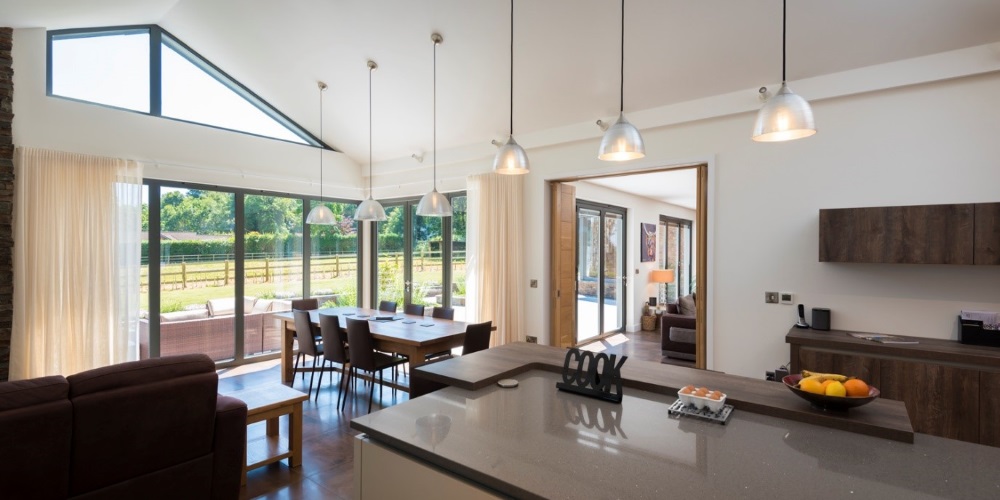
Kitchen to garden
Most kitchens and kitchen diners are located towards the back of the house, helping you make the most of your garden views and it offers opportunities for outdoor dining on a patio or area of decking.
With their level (or near-level) threshold set into the flooring, and their ability to provide wide-open access to the fresh air, bi-fold doors have become crucial to the increasingly popular concept of alfresco dining.
Read more on bi-fold doors for patios here.
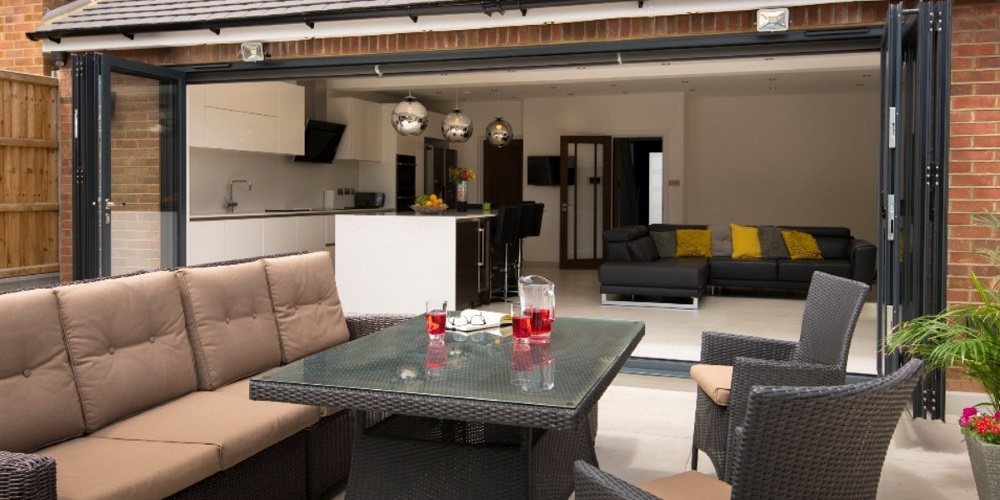
Corner bi-fold doors
Installing corner bi-folds means taking away a complete corner of a wall and replacing it with doors. Most homeowners who have corner bi-folds fitted are able to transition effortlessly between a kitchen or kitchen diner and the garden or patio.
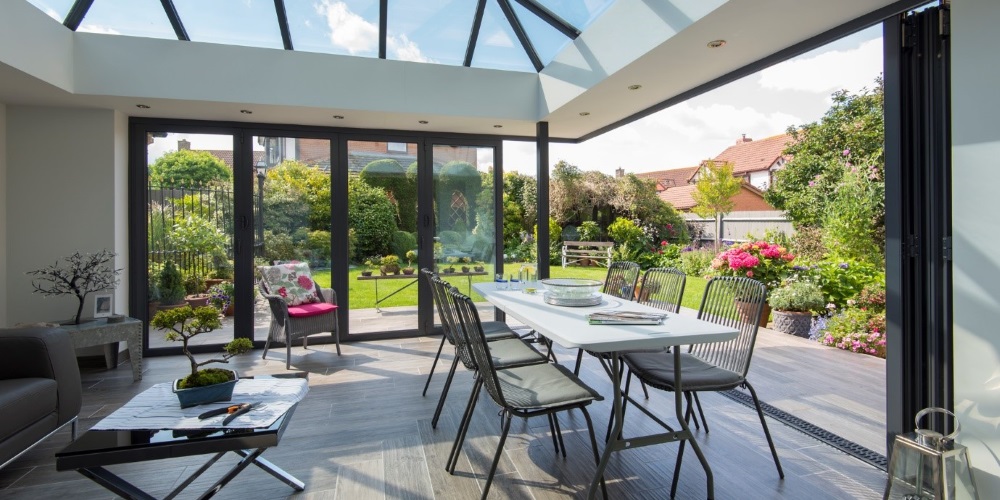
Read more about corner bi-fold doors.
Installing bi-fold doors as part of a kitchen extension
A lot of customers have bi-fold doors installed as part of a kitchen extension, due to their efficiency at providing additional space.
Their stylish concertina design allows you to fold the doors out of the way when open, to create more interior flooring space for furniture (e.g. a dining table and chairs) or permanent kitchen units such as islands and breakfast bars.
The added space isn’t the only benefit however. Bi-fold doors can either facilitate an unbroken flow of movement—enabling you to pass freely between the main rooms of the house, the kitchen extension and the garden when necessary—or provide a way of closing off certain areas or concealing little nooks and crannies.
Although many kitchen extensions lack conventional windows, the large glazed panes of bi-fold doors allow sunlight to flood into the room, lessening the need for artificial roof lights or spotlights above dining tables and other frequently used areas of the kitchen.
Read how to make the most of bi-folds in a kitchen extension.
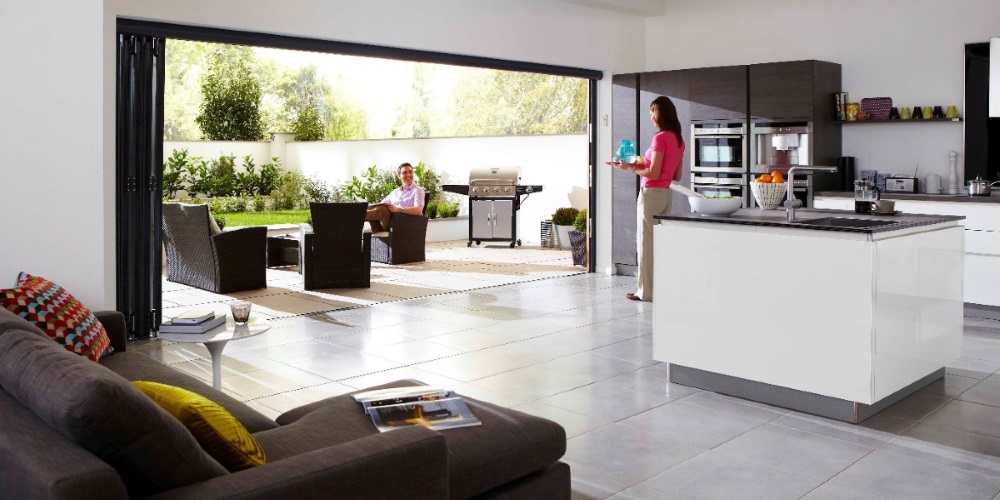
Sizes, locks, colours and blinds for kitchen bi-fold doors
Configuration, size and number of glass panes
Bi-fold doors come in a huge range of configurations, so you have lots of choice when customising exterior doors to match the design and layout of your kitchen.
For example, if you chose a 6-door set, you could have:
- three doors folding in each direction
- all six doors folding in one direction
- one door in one direction and the other five doors folding in the other direction
You can also decide whether the doors:
- fold to the left or right
- open inward or outward
The number of glass panes your doors have depends on the configuration you choose and the number of doors you select.
There’s also plenty of flexibility when it comes to the size of your doors. Not all homes can accommodate bi-folds that replace one entire wall, and most manufacturers make their doors to measure, according to the custom dimensions you provide.
Locking and security
Kitchen bi-fold doors from any reputable door company will have been designed and manufactured with security as a priority.
High-quality bi-fold doors are equipped with several features intended to make your home invulnerable to break-ins. Two of these features include:
- a multi-point locking system, that locks at several points around the door frame
- a lock and or barrel made to resist typical housebreaking techniques.
Read more on bi-fold door security and safety.
Styles and colours
You will find that most bi-fold doors are available in a wide variety of colours. Many manufacturers use the industry standard RAL colour chart, which offers over 150 different shades. This means you can always find a product to match the colours already present in your kitchen cabinetry, wall finishes and other home décor.
Read more about bi-fold door colours.
Popular colour options for bifold doors
Dark grey and white are particularly popular colour options. Black is a classic, stylish colour that works alongside a wide range of colour schemes, while the neutral white provides lightness and calm where darker colours are unable.
Wood-grain finishes
Having doors powdercoated with a wood-grain effect gives you the look of hardwoods such as oak, but with none of the associated problems that come with natural timber, such as its need for maintenance and its tendency to warp and expand in certain weathers.
See the RAL range—including wood-grain shades—in our bi-fold doors colour guide
More about our popular aluminium bifold door colours.
Powder coating
Aluminium products are given their colour using powder coating, paint or an anodised finish. Contrast with uPVC doors, which are generally coated with a much less durable laminate foil, or timber doors, which are usually painted and varnished.
Powder coating is a process that uses powdered paint to apply a coloured finish to an aluminium product. The aluminium is pre-treated then the paint is applied using an electrostatic process. It’s then heated to 200°C. A tough coating forms that’s much more hardwearing and scratch-proof than normal liquid paint and can leave a completely smooth surface.
Read more about powder coating for aluminium doors.
If you'd like to find out more about buying Origin bi-fold doors, please search here and we’ll put you in touch with a local installer.



